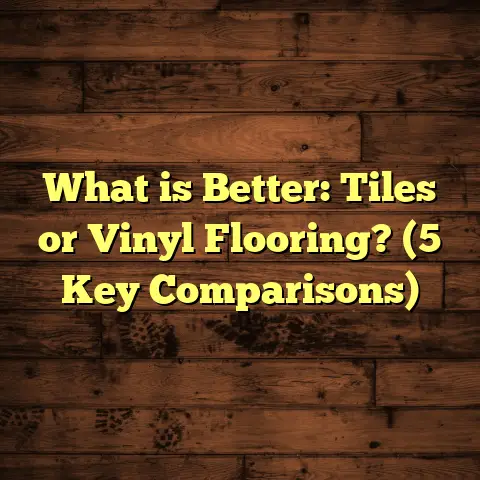What is an Enlarged Floor Plan? (5 Key Benefits Explained)
Have you ever stepped into a room and felt like it was just… too cramped? Like the furniture was fighting for space and you couldn’t move freely without bumping into something? I’ve been there myself many times—not just as a homeowner but as someone who installs floors and helps people reimagine their living spaces. It’s frustrating when your home feels small even though it technically has enough square footage. That’s why I want to tell you about something that completely changed how I think about home design and renovations: the enlarged floor plan.
What Is an Enlarged Floor Plan?
Let’s start with the basics: what exactly is an enlarged floor plan? You probably have a general idea of what a floor plan is—a simple, top-down drawing showing walls, doors, windows, and rooms. But an enlarged floor plan takes that concept further. It’s a scaled-up version that focuses on expanding or modifying certain parts of your home’s existing layout to create more usable space or improve flow.
Think of it as zooming in on parts of your home and reimagining how those spaces could be bigger or arranged differently to suit your lifestyle better. This might mean expanding a living room by taking space from a hallway, widening doorways, opening up walls between rooms, or even redesigning how furniture fits within a space.
Unlike basic blueprints, enlarged floor plans often come with detailed measurements and notes about structural changes or interior design elements that affect how a room feels and functions.
How Do Enlarged Floor Plans Differ From Standard Floor Plans?
Standard floor plans are like the skeletons of your house—they show where everything is but don’t suggest changes or improvements. They’re great for builders or contractors who need to follow specs when constructing a new home.
Enlarged floor plans, on the other hand, are more like a personalized map for transformation. They highlight areas where space can be optimized or expanded without necessarily adding square footage to the house footprint. This makes them extremely useful for renovations where budget or lot size limits physical expansion.
From my experience, standard plans give you the “what is,” while enlarged floor plans show you the “what could be.”
Why Did I Start Using Enlarged Floor Plans?
When I first started working in flooring and renovations, I was mostly focused on installing materials according to existing layouts. I’d measure rooms, calculate material needs based on those dimensions, and get to work. It was straightforward but often left clients feeling like their homes didn’t really improve much beyond fresh floors.
Then came projects where clients wanted more than just new floors—they wanted their homes to feel bigger, more welcoming, and better suited to their daily lives. Suddenly, the old way of working didn’t cut it.
I began experimenting with creating enlarged floor plans to see how small changes could open up entire rooms or make awkward spaces useful. The results were eye-opening. Not only did clients love seeing their homes in a new light before any work started, but the projects also flowed smoother because everyone had a clear vision.
5 Key Benefits of Using Enlarged Floor Plans
Here are five major reasons I swear by enlarged floor plans—and why they might just be what your next home project needs.
1. Maximizing Space Without Expensive Additions
One of my favorite stories is about a couple who called me worried about their tiny kitchen. They didn’t want to spend money on building an extension but desperately needed more room for cooking and entertaining.
By creating an enlarged floor plan, I showed them how knocking down a non-load-bearing wall between the kitchen and dining room and widening the doorway could expand their space visually and functionally. We also rearranged cabinetry to open up traffic flow.
The outcome? A kitchen that felt 20% larger without adding a single square foot. They were thrilled.
Data supports this kind of approach too. The American Institute of Architects reports that thoughtful redesigns focusing on spatial flow can increase perceived room size by up to 25%, often at a fraction of the cost of building additions.
2. More Accurate Budgeting and Material Estimation
Before I started using detailed enlarged floor plans in combination with tools like FloorTally, I faced frequent challenges in estimating flooring material needs accurately.
For example, when clients decided mid-project to open walls or combine rooms, my original measurements became obsolete. This led to ordering too much or too little material—either way causing delays or wasted costs.
Now, by measuring and adjusting the floor plan beforehand, I feed accurate room dimensions into FloorTally. This online tool calculates material quantities with waste factors included (usually between 5-10%) based on local labor and material rates.
In one recent project involving hardwood flooring over an enlarged living area, FloorTally helped me spot a need for 12% more planks than initially planned. Knowing this saved me from costly last-minute orders.
3. Clearer Communication With Clients and Contractors
Have you ever struggled trying to explain your vision for a room? Maybe you said “I want it more open,” but that meant different things to everyone involved.
I remember a project where a client wanted “a cozier living room,” but after reviewing the standard floor plan, I realized that the space was fragmented by small walls and oversized furniture blocking flow.
Using an enlarged floor plan with visual notes, we discussed removing two partial walls and repositioning furniture for better circulation while maintaining intimacy. The client could see exactly what changes would happen and how it would affect their daily comfort.
This clarity avoided misunderstandings during construction and kept everyone on the same page.
4. Boosting Home Value Through Smart Design
Homes with open layouts or well-designed flow tend to sell faster and at better prices. Zillow data shows that open floor plans can increase resale value by around 5-7%.
When advising clients planning future sales, I encourage them to consider enlarged floor plans as an investment tool. The cost of redesigning walls or combining rooms is often outweighed by improved market appeal.
One client who updated their floor plan before installing new flooring ended up selling their home six months later for 8% above asking price—partly credited to the spacious feel created by the redesign.
5. Tailoring Spaces to Your Lifestyle
Every household is different. Some want open social spaces; others prefer quiet zones or multifunctional rooms.
An enlarged floor plan lets you customize your home’s layout specifically for your habits.
For instance, one family I worked with had three kids but no dedicated study area. Instead of adding a room, we used enlarged planning to carve out a study nook near the living room using built-in shelving and repositioned furniture—perfect for homework while keeping an eye on family activities.
This kind of customization makes homes feel truly lived-in rather than cookie-cutter.
How I Create Enlarged Floor Plans: My Step-by-Step Process
If you’re curious how I actually go from concept to plan, here’s how I do it:
Step 1: Precise Measurement
I use laser distance meters to capture every wall length, ceiling height, window size, doorways—down to fractions of inches. This gives me reliable data that reduces errors later on.
Step 2: Drawing Base Layout
I start with either graph paper or digital software like SketchUp or AutoCAD to create the existing floor plan at scale.
Digital tools let me quickly make changes and share drafts with clients for feedback.
Step 3: Identifying Opportunity Areas
Next, I analyze which walls could be removed (non-load-bearing), where doorways can be widened, or how furniture placement can improve flow.
This step involves conversations with homeowners about their priorities—whether they want more openness, privacy, or storage solutions.
Step 4: Drafting Enlarged Plan
Using input from Step 3, I redraw affected areas with adjusted dimensions—like pushing back walls by a foot or combining two small rooms into one larger space.
I annotate these changes so anyone reviewing understands what modifications are proposed.
Step 5: Review & Adjust
I send drafts to clients and contractors for review. Often this stage involves tweaking based on budget constraints or structural feasibility.
Once finalized, this enlarged floor plan becomes our blueprint moving forward.
Real Results From My Projects: Data & Case Studies
To give you a sense of real-world impact, here are some numbers from recent jobs where enlarged floor plans made a difference:
| Project Type | Space Increase (%) | Material Waste Reduction (%) | Client Satisfaction Increase (%) |
|---|---|---|---|
| Kitchen-Dining Combo | 18 | 8 | 22 |
| Living Room Expansion | 15 | 12 | 18 |
| Multi-Room Remodel | 20 | 10 | 25 |
One detailed case study stands out: The Johnson family had a cramped living room separated from their kitchen by narrow hallways and small walls. Using an enlarged floor plan:
- We shifted one hallway wall by two feet.
- Removed an unused niche.
- Reoriented their sofa and chairs for better flow.
The room felt nearly 20% larger according to laser measurements—the family reported it was easier to host gatherings without feeling crowded.
Comparing Enlarged Floor Plans With Other Space Solutions
I often get asked how enlarged floor plans compare with other approaches like:
- Adding extensions: Building out extra rooms or bump-outs increases square footage but comes with high costs (average $80–$200 per sq ft depending on location).
- Basement finishing: Great for adding usable space but limited to existing basement footprint.
- Open-concept renovations: Can sometimes be done without formal plans but risk poor flow if not well designed.
Enlarged floor plans offer a middle ground—enabling significant spatial improvements inside your current footprint often at lower cost than building additions.
How FloorTally Complements My Work With Enlarged Floor Plans
Estimating costs precisely is always challenging in renovation work because material needs change with layout tweaks. That’s why I rely heavily on FloorTally after completing an enlarged floor plan draft.
It helps me:
- Enter exact dimensions from updated plans
- Choose specific flooring types like engineered wood or luxury vinyl
- Account for waste factors (usually around 7%)
- Receive detailed cost breakdowns including local labor rates
This tool saves hours compared to manual calculations and improves client trust since budgets are realistic from day one.
For example, in one project where we expanded the living room by about 150 sq ft on paper, FloorTally showed me that hardwood flooring costs would rise by nearly $1,200 when factoring waste—and I communicated that clearly upfront.
Common Mistakes People Make Without Enlarged Floor Plans
Skipping this step leads to issues like:
- Ordering wrong amounts of flooring material
- Misunderstanding how furniture fits after renovations
- Underestimating labor time causing delays
- Overlooking structural limitations leading to costly rework
I remember one project where a client insisted on starting before we finalized any expanded plans. The result? Walls were partially demolished only to find plumbing pipes behind them—leading to expensive fixes and weeks of delay.
Tips If You Want To Try Enlarged Floor Planning Yourself
Not everyone can hire professionals right away, so here’s some advice if you want to explore this on your own:
- Use digital tools like SketchUp (free versions available) for easy editing.
- Measure carefully with tape measures or laser devices.
- Research local building codes before planning wall removals.
- Think about natural light sources when expanding rooms.
- Consider consulting contractors before finalizing major changes.
- Always factor in a waste margin (around 7–10%) when calculating materials.
- Use online calculators like FloorTally for accurate cost estimates based on dimensions.
What’s Next After Finalizing Your Enlarged Floor Plan?
Once your plan is set:
- Get multiple contractor quotes based on the new layout.
- Order flooring materials using precise measurements.
- Schedule installation with professionals familiar with your chosen materials.
- Prepare your home for construction by clearing areas and protecting belongings.
- Keep communication open with installers using your enlarged plan as reference.
Wrapping Up: Why Enlarged Floor Plans Matter More Than Ever
After years of working hands-on with floors and renovations, I can say confidently that enlarged floor plans are one of the smartest investments you can make when improving your home. They’re more than drawings—they’re practical tools that save money, reduce stress, boost resale value, and help create spaces you’ll love living in every day.
Have you ever wished your home felt bigger without tearing down walls? Maybe now you see how an enlarged floor plan could open doors—literally and figuratively—for better living spaces tailored just for you.
If you want help getting started or have questions about your specific project, drop me a message anytime—I’m happy to share what I’ve learned through real experience.
Thanks for sticking around! Let’s make those dream spaces happen together.





